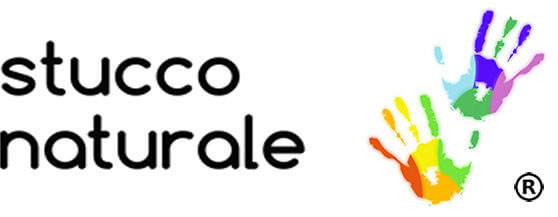Instructions for the application of a trowel floor with Stucco Extra
Step-by-step instructions Stucco Extra
1) Surface preparation:
When used on the floor: In the case of a beautifully smoothed screed, the first layer can be applied right away; in the case of cracks or sanding substrates, pre-filling with tile adhesive and reinforcement fabric is recommended. When used on walls: If lime plaster, cement plaster or gypsum cement plaster is present as a plaster base, the priming can be started immediately. However, if you do not have any mineral substrates, such as dispersion paints, plasterboard, glass, tiles, MDF and also reinforced concrete, etc., prime the surface with an adhesive primer. The adhesion primer with marble grains must dry out for at least 12 hours. In general, a primer is recommended, as the absorbency is adjusted and thus facilitates application. If tiles are to be coated, here are the instructions for preparing the substrate. When used on the stairs: For the stairs, you need the proper preparation. Stainless steel tile edges are smoothed in to obtain solid edges and to ensure a stable appearance. You can find suitable tile edges here.
2) Coating build-up:
Stucco Extra is dyed with a coloured dough to the chosen colour. The colour examples you see in the colour pigments section have all been made with Stucco Veneziano. You will find the mixing tables to get to this shade even with the coarser plasters by following this link. (Click here) You can read the instructions for preparing the coloured dough below in the text. The white or coloured filler is applied to the prepared surface in grain strength and then dried for 12 hours. The material must be stirred very well beforehand and up to 1% water can be added if necessary. Apply so much that the plaster primer is well covered. It is best to use a smoothing trowel with a rigid blade. The consumption for the first coat is approx. 1000 grams/m². This layer should be allowed to dry for 12 hours. Now use a trowel to scrape off the surface so that there are no more scratching grains or coarse putty hits. Clean the surface with a vacuum cleaner. This coating is repeated to achieve a hard-wearing and very smooth surface. To do this, smooth the surface with pressure using a Venetian smoothing trowel. If the coating is white, the Venetian PVC trowel is recommended to avoid metal abrasion marks. If the surface is not smooth enough, it can be reworked with a small amount of Stucco Veneziano. The surface is then sanded with P400 and vacuumed. After drying, the coating is ready for sealing.
3) Final coating – Sealing
In order to protect the floor from wear and tear and dirt, we recommend a treatment with Stucco Wet Room Impregnation or alternatively a varnish with PUR sealing. The surface becomes silky matt and insensitive to dirt. Water does not penetrate the floor and can easily be wiped away. This makes the surfaces harder, insensitive to scratches and easy to clean.
As an alternative to the layer-forming PUR sealant, there is a water vapour-diffusing and water-repellent impregnation. You can find the so-called stone oil right here.
Dry paints and color pastes
Up to 10 % pigments (by weight) can be stirred into the putty. The lime cannot bind more and chalking would occur. If the dry paints, also called pigments, are stirred into the putty, a beautiful coloured mass is created. However, there is a high probability that pigment spots will appear. This means that some pigments will leave traces in the form of drivers or dots when filling the compound. This does not necessarily have to be a disadvantage, it can also be seen as a nice side effect. However, if you want to avoid these pigment spots, mix yourself with a color paste. This is how it works: For 1000 g pigments approx. 800 ml liquid are used (160 ml wetting agent and 640 ml water). Pour the liquids into a container and add the pigments, stir well and grate; crush lumps at the edge of the container. Use a painting knife. It is best to make a note of your mixing recipe in order to be able to produce the same shade again. Let this paste soak for at least 3 hours. However, the coloured dough can also remain overnight without any problems. During this time the container should be covered. Afterwards mix into the putty and stir well. The best mixing result is achieved if the contents are emptied into a separate bucket and mixed again well with a mixer. The putty is then immediately ready for use. Pigments have the highest colour intensity and set no limits to your creativity. However, you should only use lime-tolerant pigments. The fillers, whether dyed or in natural white, can be stored for many years if stored correctly. For this purpose, the putty must be covered with a foil and the container sealed tightly. Exception: Ultramarine blue must always be applied on the same day and cannot be stored. Tip: If chrome oxide green, cobalt blue, titanium white or similar hard pigments are used, a Venetian PVC smoothing trowel is used for compacting. If you compact with a steel spatula, the pigments grind off the steel and metal abrasion marks are the result – grey stripes and stains.
Product information
Stucco Extra is a natural white putty for use on decorative walls and floors. Due to its high alkalinity, it is resistant to mould fungi. Highly vapour permeable.
Full declaration: Marble lime [Ca(OH)²], marble powder [CaCO³], cristobalite, water, cellulose.
Yield: approx. 2000 g/m² for 2 layers; depending on substrate and application, consumption may vary!
Specific weight: approx.1,48kg/l
Ph value: 12,5
Storage conditions: Frost-free and in closed containers, covered with a PVC film and a layer of water, durable for many years.
Safety instructions: R36/38: Irritating to eyes and skin.





